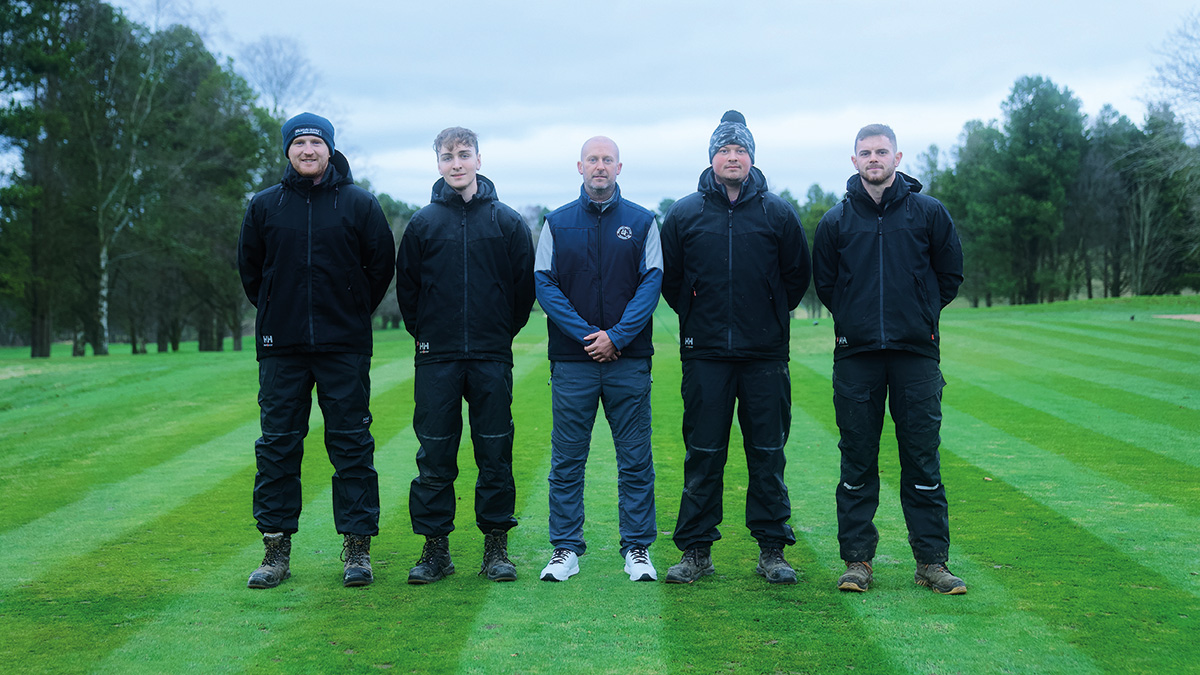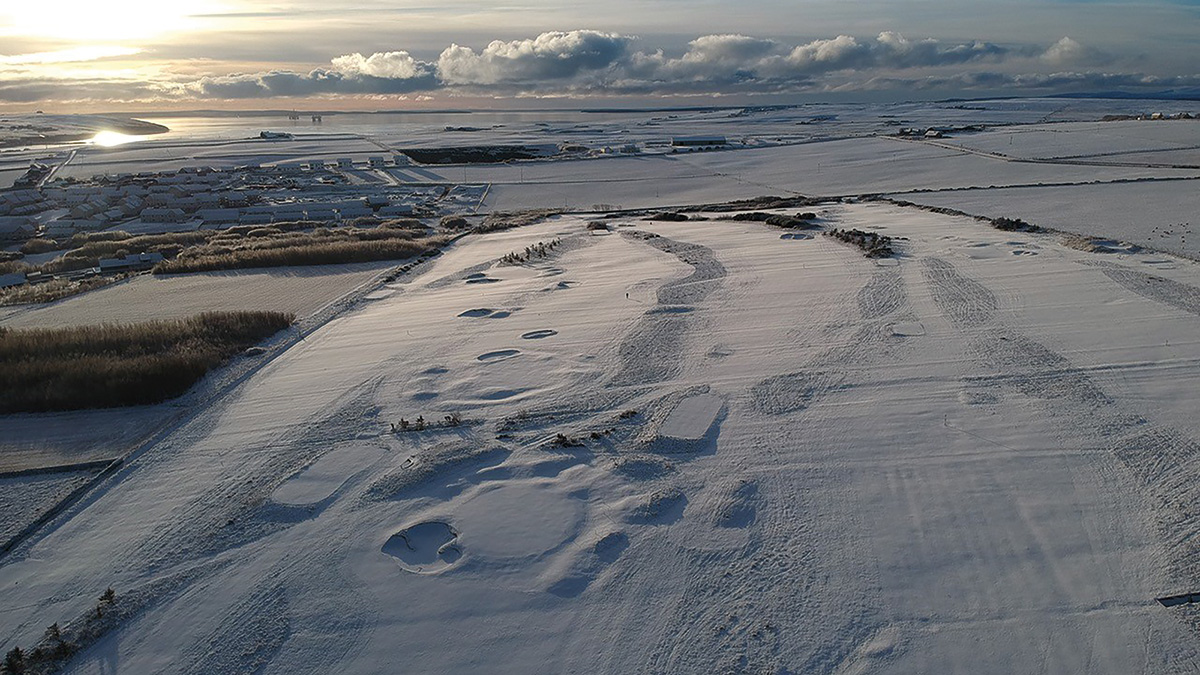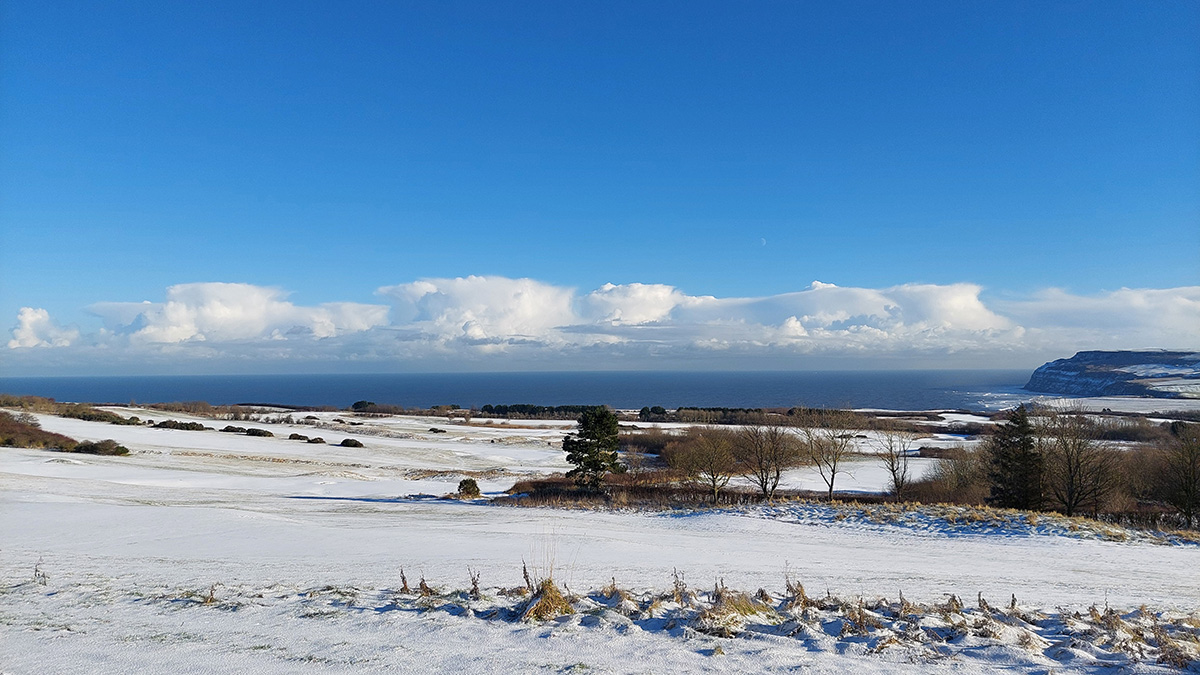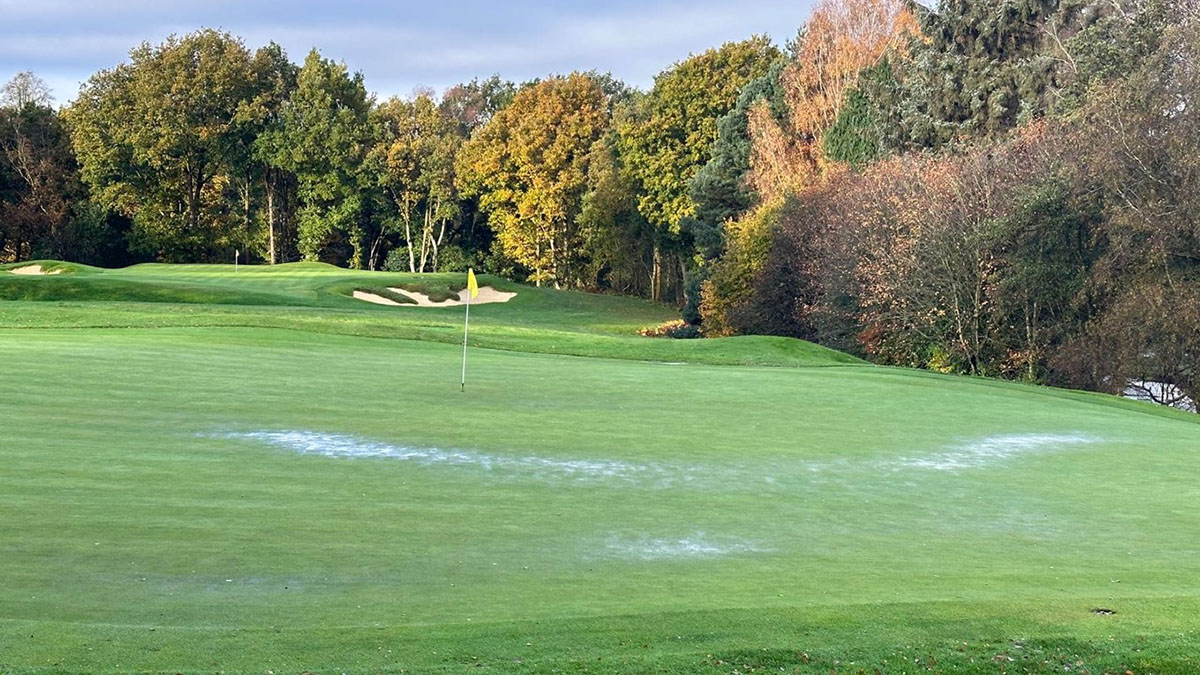- Homepage
- News and Features
- Opinion: Temporary greens, course closures, topdressing
Opinion: Temporary greens, course closures, topdressing
We spoke to three course managers from across the UK to understand how they overcome common problems that arise on golf courses during winter.
Meet the panel

Mark Crossley
Course Manager, Prestbury Golf Club
“A lot of our challenges come down to winter wear as much as anything. We’ve got quite a few pinch points – the 1st, 3rd, 5th and 17th greens are all within 150 yards of each other.
“Our tees are very close to the greens, which means the walk-off areas are under a lot of stress. No members or greenkeepers like to see ropes around the course, but at times it’s a necessary evil. Ultimately, we do our best to produce a golf course that members can be proud of 12 months a year.”

Greg Fitzmaurice MG
Course Manager, Hunley, North Yorkshire
"We’re an unusual course as we’re on the cliff tops but we’ve got heavier soil. I would describe it as coastal moorland.
“The course plays very much like a links course – it’s dry for 9-10 months of the year, the ball bounces, it’s windy and it’s quite open. But the challenges are different because we’re not on sand, so in the depths of winter we can get wet.
“We’re somewhere between a parkland course and a links course but we seem to avoid the extremes that either of those types of courses might have.”

Chris Rae
Course Manager, Orkney Golf Club, Northern Isles
“The biggest factor up here is the wind and the storms, which affects what you can do on the course. Do you leave the shed when it’s 60 miles-per-hour winds? Probably not safe to do that, and it’s probably not safe for golfers, although they’ll often go out anyway. It has a wear and tear impact on the course, so you have to put provisions in place.
“We’re pretty good in terms of coverage for daylight, no shady bits that never see the sun, but in winter we go down to about six hours of daylight a day. The grass goes fully dormant.”

What is your policy on winter mats?
Mark : “I was keen to bring them in when I first started at Prestbury, but the members were initially resistent. That changed when we reopened following COVID and had an upsurge in rounds. We decided to use mats to protect several difficult areas and that established in people’s minds that it could be a good thing because when spring came around, those areas were in a better condition than the members had come to expect.
“What we have now is four areas around the course where we place 12 to 15 mats that we have the freedom to move.
“That’s something members are not only used to now, but they see the benefit of it, and some of them are calling for more of it and taking their own mats around.”
Chris: “It’s something I’ve thought about. I can’t see the members getting involved, but I would like to use them. We don’t get a whole lot of rounds through the winter, so we’re not too bad for divots in that there’s not too much wear, but I am noticing an increase the last three or four years since Covid in terms of the number of rounds. I’d be keen to give people the choice, but it’s not something we’d want to enforce.”
Greg: “We don’t use them as it doesn’t seem necessary for us. We do have pinch points like shorter holes or long par-5s where you’ve got those areas that get peppered because people are hitting a wedge into the green. We tend to divot in the spring and we’re okay. I like the idea of having a box of mats in the shop so it’s optional, because you might find sometimes you’re hitting a ball and getting mud flying back at you. Some people might prefer to play off mats in that scenario and that’s better for the player and the course.”

What height of grass do you like your greens to be in the winter?
Greg: “We don’t cut that short anyway, but we do raise the height of cut on the greens. At the moment [August] we’re at 4.5mm, which is probably on the high side for the average club, and we’ll go up to between 5-6mm. It’s a judgement call but we normally knock them up about a millimetre and time that with a bit of a feed and maybe topdress as well.”
Mark: “We’ll start to raise our heights of cut from early October from 3mm upwards in increments of 0.5mm until we hit 5mm at some point in November, and that just adds a bit of protection to the plant. When growth slows down and you get the onset of disease pressure during the late autumn months, having a healthy plant is pivotal, especially now as we’re losing products left, right and centre. The stronger the plant is going into the winter period, the stronger it’ll be coming out of it.”
Chris: “We normally cut to about 4.2mm and we can’t go much lower than that with the wind here. We don’t have irrigation so we can’t soften the greens, and we’ve got a couple on slopes so that’s borderline for us anyway. Any lower than that and I’d probably get the sack because people will have balls rolling back to their feet. In winter we incrementally increase it until we get up to 6.5mm.”
Where do you stand on the use of winter tees?
Mark: “We try to give the members the full experience as often as possible, but we’re an inland course in Cheshire and that sometimes means we need winter tees. We don’t generally use winter tee mats, so even our winter tees are grass, which I think helps politically when members are playing a shorter course in winter.
“It’s an interesting time now with year-round qualifiers and the pressure on course managers to have a measured course 12 months a year. That’s creating more issues in terms of wear and tear on teeing ground. Winter tees weren’t necessarily part of a measured course before, but they are now and that’s a new challenge for us all.”
Chris: “I’ll bring them in when they are required. It might be that it’s getting wet beside a tee and I’ll just say, ‘Right, we’re going to the winter tee on this hole’, and gradually you end up on full winter tees by December. We’ve got 10 or 11 permanent astroturf tees and they’ll tend to come in from November until around March, depending on the weather. For the other seven holes, we’ll just put tee markers to the side in a decent spot. We don’t have any official comps from the end of September so the yardage isn’t an issue, but it’ll be a good 1,000 yards shorter.”
Greg: “We usually put the par-3s on mats first because they get a bit more hammer. Sometimes it’s easier just to move completely over to mats from October, but the director of golf and I are both of the opinion that playing off mats might put visitors off and so we’ll phase them in depending on the conditions.”

What is your policy on winter greens – temps or no temps?
Mark: “Our winter greens policy is to treat them as frost greens, so if there’s any hint of frost we go to the temporary greens. It’s very rare; there was the odd occasion last winter and this spring where a couple of the greens became unplayable, so then the flags went on the temps. But generally speaking, we play off the greens all year round apart from in frosty conditions.”
Chris: “We use winter greens on every hole by cutting somewhere near the apron or front of the green that is dry and not too sloped. This can make the hole a good 50 yards shorter than usual. We also use our putting green as a double green for our 18th and 15th holes, so we don’t have that as a putting green in winter. Once we’re on winter greens we stay on them.”
Greg: “When I started my career at a different course, they firmly believed winter greens were necessary to protect the putting surfaces. But when I came to Hunley, there wasn’t a culture of using winter greens because there wasn’t really anywhere to place them. In my time here I’ve not experienced severe problems from playing on the greens in winter.”
When do you usually switch to preferred lies?
Chris: “It’s pretty much preferred lies all winter. The timing of when it comes in is different every year and it just depends on ground conditions. We had a damp summer so the water table is pretty high and that’ll mean they’ll probably come in a little earlier this year.”
Mark: “As England Golf tell us to, basically, so from the start of November to the end of March. It was great that England Golf showed a little bit of common sense this year in extending preferred lies all through May. We had a Cheshire championship in the second week of May and we actually came off preferred lies the week prior to that, which was good.”
Greg: “The director of golf will liaise with me and he’ll ask questions. Usually the golfers are pretty good, they’ll start saying they’re getting a bit of mud on the ball, at which point we’ll say it’s time to bring in preferred lies.”
Where do you stand on overseeding and topdressing?
Mark: “We vertidrain, topdress and seed the creeping bentgrass and we believe that lengthens the playing season. The work we do in applying around 90 tonnes of topdressing will firm the greens up in anticipation for the wetter autumn months. This will enable more play on the greens during those months, breaking down the organic matter, relieving compaction. It’s a couple of weeks of pain that allows us an elongated playing season.”
Chris: “We topdress twice a year, in spring and autumn. I question whether it’s something that’s always needed when you’re a club with a limited budget. I’m a bit old-school, but one thing I have changed is I used to spike, then topdress and rub it in, but I saw a video on social media where they were topdressing first, then spiking and rubbing it in, and that’s made a huge difference in getting the sand in.”
Greg: “In the past we have done something called ‘pot planting’ where we hollow core the greens, push seeds into the holes and then topdress, but we don’t completely fill the holes. It’s to protect those new seedlings through the winter and it’s like they’re in a little plant pot below the surface. If money was no object we’d do it every year.”

What does it take for you to close your course?
Greg: “I have quite a high tolerance so for us it has to get to the point where it’s simply not playable. If there’s nowhere to take relief from casual water because it is everywhere, then it’s time to close the course. We make a decision first thing in the morning and it applies all day – there’s no mid-morning review or anything.”
Chris: “It’s a fine line with course closures and you’re not always going to get it right. My mistake when I came here at the start was forgetting how important it is in a small community for people to have the option to go out and play golf. There’s one group goes out every morning – summer or winter – three of them, all in their 80s, and they just want to play. I keep an eye on the weather and sometimes I might even give the heads-up the night before so people can plan. If they’re out on a Saturday night, they might enjoy a few more pints!”
Mark: “We have a tiered system in the course policy document. Tier one is fully open and it goes all the way down to tier seven, which is course closure. In the midst of that is stuff like no buggies, no electric trolleys, pull trolleys only, carry only, before getting to course closure. It’s quite rare but it’ll be on health and safety grounds, course protection grounds, or a combination of both.”
Why do you rope off certain areas?
Greg: “We put ropes out in the late autumn so we can manage traffic with buggies and trolleys. If you don’t have the ropes when the grass isn’t growing in the winter, everybody walks right next to the green and you get excessive wear in the same place. We put a horseshoe round the green to direct people around a certain path, We’ll move the rope to a new spot once a week.
Chris: “We have four or five areas on the course, for example where people might walk between a bunker and a green, and we just block those off. The 14th green is really soft down to the left so we just rope off that whole area and direct traffic around the other way, which is a bit of a faff, but it prevents trolley marks through the mud. You always get one who’ll just ignore it and go under the ropes and you can see the marks, but we do our best.”
Mark: “We generally confine our roped-off areas to green surroundings just for some traffic management, to move people away from the summer high-traffic areas towards the winter traffic areas. We don’t have many, but in certain areas like the run-off between bunkers and green surrounds it’s a necessary evil.”
What are the best ways of protecting vulnerable areas?
Mark: “We look at that from a pre-emptive point of view, as opposed to a reactionary point of view. We take preventative measures and get the ropes and the hoops out there sooner and make sure there’s no damage that could last all winter and into the playing season. It’s about educating the staff as well in areas where they shouldn’t drive in wet conditions as that is just as important as educating the members.”
Greg: “We’re quite lucky as we’re able to get rid of water fast, so we don’t get areas of standing water all the time. It’s more about pinch points where there’s not much room for moving golfers around, and what we’ve done there is installed hardstanding paths. We’ve only got two or three areas of the course that could do with fixing from that point of view.” â¤
Why winter isn’t all bad
- It’s when we do the unseen work
Greg: “I really enjoy winter because it’s an opportunity to make improvements. I discuss with the boss what improvements we’re going to make and spend the winter implementing them, and it’s quite good to get your teeth into that. It might be structural changes to the course that improve the golfers’ experience, like introducing a new bunker to improve the strategy of a hole or extending a green. Other times it can be softening surroundings and landscaping areas to make it easier to get a mower onto, for example. There’s a lot of invisible stuff that greenkeepers do that golfers aren’t really bothered about. I mean, ultimately, you go to a restaurant, you buy a meal, you’re not that interested what utensils they’re using.”
- Winter hours are shorter
Chris: “It’s a bit of a double-edged sword. We work different hours for six months a year. So summertime, we work 45 hours until the end of September, and work overtime on top of that, so it can be 50 to 60 hours some weeks. By October, we go to winter hours, which is 25 hours a week, and that break is just like, ‘Thank God’. You’re just worn out by the time October comes. Then you get into kind of Christmas and you’re like, ‘Yeah, this is good’. But then by about March you’re ready to go again and feeling refreshed. I like to visit family in Australia around February because that’s the worst part here, with the long, cold, dark, windy nights.”
What’s more important: optimal winter playing conditions or course preservation?
Greg: “It depends on where the club is at and what the aims are. We transitioned our grass species when I first joined and that was very much a long-term goal, and so we had to sacrifice the short-term playability of the greens through the winter and sometimes even a little bit in the summer. We had to have slightly slower greens for the first couple of years while we kept the height up so we could change the environment for the grasses that we wanted. The benefit of having done that work is that we can now think more about the day-to-day conditioning.”
This article was first published in Your Course, the twice-yearly publication from the British and International Golf Greenkeepers Association. Your Course invites golfers to gain a deeper appreciation of what preparing and maintaining a golf course really involves. Head to www.bigga.org.uk to find out more.
Tags
Author

